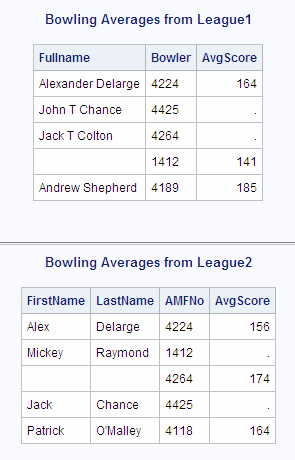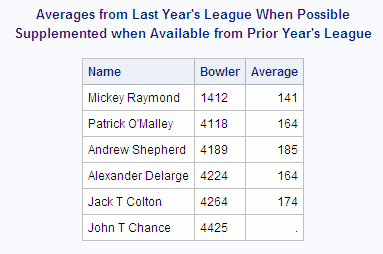Overlaying Missing Data Values
Problem
You are forming teams
for a new league by analyzing the averages of bowlers when they were
members of other bowling leagues. When possible you will use each
bowler's most recent league average. However, if a bowler was not
in a league last year, then you will use the bowler's average from
the prior year.
Background Information
There are two tables,
LEAGUE1 and LEAGUE2, that contain bowling averages for last year and
the prior year respectively. The structure of the tables is not identical
because the data was compiled by two different secretaries. However,
the tables do contain essentially the same type of data.
data league1;
input @1 Fullname $20. @21 Bowler $4. @29 AvgScore 3.;
cards;
Alexander Delarge 4224 164
John T Chance 4425
Jack T Colton 4264
1412 141
Andrew Shepherd 4189 185
;data league2;
input @1 FirstName $10. @12 LastName $15. @28 AMFNo $4. @38 AvgScore 3.;
cards;
Alex Delarge 4224 156
Mickey Raymond 1412
4264 174
Jack Chance 4425
Patrick O'Malley 4118 164
;
Solution
The following PROC SQL
code combines the information from two tables, LEAGUE1 and LEAGUE2.
The program uses all the values from the LEAGUE1 table, if available,
and replaces any missing values with the corresponding values from
the LEAGUE2 table. The results are shown in the following output.
proc sql;
title "Averages from Last Year's League When Possible";
title2 "Supplemented when Available from Prior Year's League";
select coalesce(lastyr.fullname,trim(prioryr.firstname)
||' '||prioryr.lastname)as Name format=$26.,
coalesce(lastyr.bowler,prioryr.amfno)as Bowler,
coalesce(lastyr.avgscore,prioryr.avgscore)as Average format=8.
from league1 as lastyr full join league2 as prioryr
on lastyr.bowler=prioryr.amfno
order by Bowler;How It Works
This solution uses a
full join to obtain all rows from LEAGUE1 as well as all rows from
LEAGUE2. The program uses the COALESCE function on each column so
that, whenever possible, there is a value for each column of a row.
Using the COALESCE function on a list of expressions that is enclosed
in parentheses returns the first nonmissing value that is found.
For each row, the following code returns the AvgScore column from
LEAGUE1 for Average:
coalesce(lastyr.avgscore,prioryr.avgscore) as Average format=8.If this value of AvgScore is missing, then COALESCE returns the AvgScore column from LEAGUE2 for Average. If this value of AvgScore is missing, then COALESCE returns a missing value for Average.
In the case of the Name
column, the COALESCE function returns the value of FullName from LEAGUE1
if it exists. If not, then the value is obtained from LEAGUE2 by
using both the TRIM function and concatenation operators to combine
the first name and last name columns:
trim(prioryr.firstname)||' '||prioryr.lastname
Finally, the table is
ordered by Bowler. The Bowler column is the result of the COALESCE
function.
coalesce(lastyr.bowler,prioryr.amfno)as BowlerBecause the value is obtained from either table, you cannot confidently order the output by either the value of Bowler in LEAGUE1 or the value of AMFNo in LEAGUE 2, but only by the value that results from the COALESCE function.
Copyright © SAS Institute Inc. All rights reserved.

